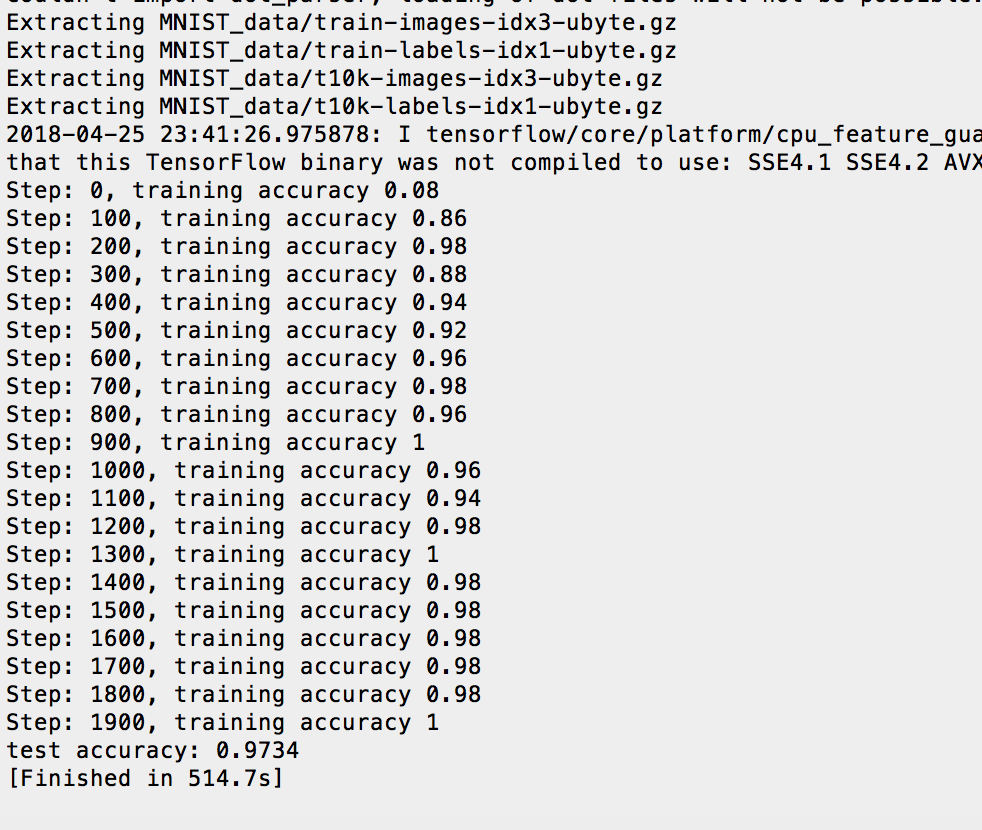参考书目:《Tensorflow实战》
环境:macOS-10.13.4, Python-3.6, Tensorflow-1.4.1
CNN简介
CNN: 卷积神经网络
功能:图像识别,现在也可以用于视频啊,时间序列等
早期难点:提取特征
与SIFT、HoG等算法的区别:特征提取+分类训练两个过程融合,训练的时候即自动提取最有效的特征
组成单位:卷积层
核心:每一层卷几层里的卷积核(滤波器
卷积层计算公式:\(conv = AF(img \circ W + b)\),其中AF表示激活函数,img是图像矩阵,W是卷积核,圈是进行卷积,b是bias。
工作原理直观解释:https://www.zhihu.com/question/39022858
CNN如何提取特征的:http://www.360doc.com/content/18/0116/11/47852988_722351618.shtml
手写数字识别
先导入数据集,开个tf会话:
from tensorflow.examples.tutorials.mnist import input_data
import tensorflow as tf
mnist = input_data.read_data_sets("MNIST_data/", one_hot=True)
sess = tf.InteractiveSession()
然后准备好权重和参数,因为要有很多的权重和参数生成,所以定义它们的生成函数:
def weight_variable(shape):
initial = tf.truncated_normal(shape, stddev=0.1)
return tf.Variable(initial)
def bias_variable(shape):
initial = tf.constant(0.1, shape=shape)
return tf.Variable(initial)
下面定义卷积层和池化层,因为也需要很多,重复利用,所以写生成函数。
其中卷积层参数:x输入,W卷积参数,包含卷积核尺寸,通道数量,卷积核数量,如[5, 5, 1, 32],表示5*5,单通道,32个卷积核。Strides表示移动步长,具体解释看上面第二篇。Padding表示边界处理方式。
其中池化层参数:nn.max_pool表示最大池化,x输入,ksize表示将22降为11,strides表示步长,padding表示边界处理方式。
def conv2d(x, W):
return tf.nn.conv2d(x, W, strides=[1,1,1,1], padding="SAME")
def max_pool_2x2(x):
return tf.nn.max_pool(x, ksize=[1,2,2,1], strides=[1,2,2,1], padding="SAME")
然后定义输入口,和之前讲的多层感知机基本一样,主要是将图片又转回了28281的结构
x = tf.placeholder(tf.float32, [None, 784])
y_ = tf.placeholder(tf.float32, [None, 10])
x_image = tf.reshape(x, [-1, 28, 28, 1])
然后定义第一层卷积层,提取32个图像特征:
W_conv1 = weight_variable([5, 5, 1, 32])
b_conv1 = bias_variable([32])
h_conv1 = tf.nn.relu(conv2d(x_image, W_conv1) + b_conv1)
h_pool1 = max_pool_2x2(h_conv1)
然后定义第二层卷积层,提取64个图像特征:
W_conv2 = weight_variable([5, 5, 32, 64])
b_conv2 = bias_variable([64])
h_conv2 = tf.nn.relu(conv2d(h_pool1, W_conv2) + b_conv2)
h_pool2 = max_pool_2x2(h_conv2)
经过两次22最大池化后,图片尺寸由2828变为77,由于第二次提取了64个特征,所以输出的是77*64的tensor,所以变形之后,连接一个全连接层(节点数量1024):
W_fc1 = weight_variable([7 * 7 * 64, 1024])
b_fc1 = bias_variable([1024])
h_pool2_flat = tf.reshape(h_pool2, [-1, 7*7*64])
h_fc1 = tf.nn.relu(tf.matmul(h_pool2_flat, W_fc1) + b_fc1)
再keep_prob和dropout减轻过拟合:
keep_prob = tf.placeholder(tf.float32)
h_fc1_drop = tf.nn.dropout(h_fc1, keep_prob)
最后连接softmax层后输出:
W_fc2 = weight_variable([1024, 10])
b_fc2 = bias_variable([10])
y_conv = tf.nn.softmax(tf.matmul(h_fc1_drop, W_fc2) + b_fc2)
定义损失函数,优化器:
cross_entropy = tf.reduce_mean(-tf.reduce_sum(y_ * tf.log(y_conv), reduction_indices=[1]))
train_step = tf.train.AdamOptimizer(1e-4).minimize(cross_entropy)
准确率:
correct_prediction = tf.equal(tf.argmax(y_conv, 1), tf.argmax(y_, 1))
accuracy = tf.reduce_mean(tf.cast(correct_prediction, tf.float32))
训练20000次:
tf.global_variables_initializer().run()
for i in range(20000):
batch = mnist.train.next_batch(50)
if i % 100 == 0:
train_accuracy = accuracy.eval(feed_dict={x:batch[0], y_:batch[1],keep_prob:1.0})
print("Step: %d, training accuracy %g" %(i, train_accuracy))
train_step.run(feed_dict={x:batch[0], y_:batch[1], keep_prob:0.5})
print("test accuracy: %g"%(accuracy.eval(feed_dict={x:mnist.test.images, y_:mnist.test.labels, keep_prob:1.0})))
总代码如下:
from tensorflow.examples.tutorials.mnist import input_data
import tensorflow as tf
mnist = input_data.read_data_sets("MNIST_data/", one_hot=True)
sess = tf.InteractiveSession()
def weight_variable(shape):
initial = tf.truncated_normal(shape, stddev=0.1)
return tf.Variable(initial)
def bias_variable(shape):
initial = tf.constant(0.1, shape=shape)
return tf.Variable(initial)
def conv2d(x, W):
return tf.nn.conv2d(x, W, strides=[1,1,1,1], padding="SAME")
def max_pool_2x2(x):
return tf.nn.max_pool(x, ksize=[1,2,2,1], strides=[1,2,2,1], padding="SAME")
x = tf.placeholder(tf.float32, [None, 784])
y_ = tf.placeholder(tf.float32, [None, 10])
x_image = tf.reshape(x, [-1, 28, 28, 1])
W_conv1 = weight_variable([5, 5, 1, 32])
b_conv1 = bias_variable([32])
h_conv1 = tf.nn.relu(conv2d(x_image, W_conv1) + b_conv1)
h_pool1 = max_pool_2x2(h_conv1)
W_conv2 = weight_variable([5, 5, 32, 64])
b_conv2 = bias_variable([64])
h_conv2 = tf.nn.relu(conv2d(h_pool1, W_conv2) + b_conv2)
h_pool2 = max_pool_2x2(h_conv2)
W_fc1 = weight_variable([7 * 7 * 64, 1024])
b_fc1 = bias_variable([1024])
h_pool2_flat = tf.reshape(h_pool2, [-1, 7*7*64])
h_fc1 = tf.nn.relu(tf.matmul(h_pool2_flat, W_fc1) + b_fc1)
keep_prob = tf.placeholder(tf.float32)
h_fc1_drop = tf.nn.dropout(h_fc1, keep_prob)
W_fc2 = weight_variable([1024, 10])
b_fc2 = bias_variable([10])
y_conv = tf.nn.softmax(tf.matmul(h_fc1_drop, W_fc2) + b_fc2)
cross_entropy = tf.reduce_mean(-tf.reduce_sum(y_ * tf.log(y_conv), reduction_indices=[1]))
train_step = tf.train.AdamOptimizer(1e-4).minimize(cross_entropy)
correct_prediction = tf.equal(tf.argmax(y_conv, 1), tf.argmax(y_, 1))
accuracy = tf.reduce_mean(tf.cast(correct_prediction, tf.float32))
tf.global_variables_initializer().run()
for i in range(20000):
batch = mnist.train.next_batch(50)
if i % 100 == 0:
train_accuracy = accuracy.eval(feed_dict={x:batch[0], y_:batch[1],keep_prob:1.0})
print("Step: %d, training accuracy %g" %(i, train_accuracy))
train_step.run(feed_dict={x:batch[0], y_:batch[1], keep_prob:0.5})
print("test accuracy: %g"%(accuracy.eval(feed_dict={x:mnist.test.images, y_:mnist.test.labels, keep_prob:1.0})))
运行结果:
我这个省时间就训练了2000次,也花了500多秒。
